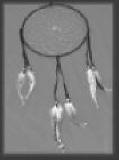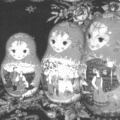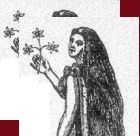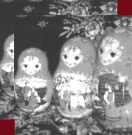| |
 Gabriella Vöő Gabriella Vöő
Voices from the American Frontier
The essay ”Voices from the Borderlands: Identity and Expression in
Native American, Mexican-American and Asian-American Fiction” gives an
overview of American ethnic writing since the 1960s, focusing on the
redefinition of the term ”frontier” as a critical paradigm. A brief
survey of the disciplinary history of American literary studies brings into
focus historical and critical narratives claiming that American culture owes
its distinctness to the Frontier. Initially elaborated in 1893 by
Frederick Jackson Turner, the hypothesis inspired, between the 1920s and
1960s, several nationalistic critical narratives. Such narratives imply that
great literary works of the nineteenth and twentieth centuries – from
Thoreau, Hawthorne, Melville and Twain to Salinger, Ginsberg and Kerouac
– reflect a redemptive experience of space. On the periphery of the
„traditional” Anglo-American literary canon, however, there are works that
record experiences in which the Frontier is not the scene of spiritual
liberation, but a homeland invaded. Native American, Chicano/a and
Asian-American literary expression runs counter to both the Anglo-American
expansionist view of the Frontier, and the major ethnic stereotypes of
Euro-American culture.
The question of identity is central in recent ethnic
fiction. Native American authors N. Scott Momaday, Leslie Marmon Silko
and Louise Erdrich problematize racial and cultural hybridity:
many of their novels rest on plots of alienation from, and reintegration
into the ethnic community. The works of Chicano/a writers Rudolfo Anaya,
Sandra Cisneros and Gloria Anzaldúa integrate distinct cultural
practices and celebrate multiple loyalties. Asian American authors
Maxine Hong Kingston, Amy Tan and Frank Chin view identity as a
construct, one that is consciously assumed and adopted, constantly contested
and negotiated. In recent ethnic writing, quests for healing and belonging
are rendered by narrative techniques building on strategies of oral
storytelling. Such techniques owe less to Modernist predecessors than to
traditional, communal story-telling practices. The works of American ethnic
authors invite readers to widen their interpretive horizon, inspiring major
paradigm shifts in critical discourse as well.
Edit Gilbert invited
contributors to the project consider, in their own fields, possible points
of intersection with her admittedly subjective narrative on the last decades
of Russian writing. Along my discussion of a section of recent American
literature several unexpected similarities occurred which challenge the
prevalent conception of Russian and American literatures as polar opposites.
The most relevant common features are the counterpointing of the
experience of empire-building, and the resistance to imposed
discursive strategies of hegemony. Even some of the themes are common,
such as experiences of internment, pioneer stories and narratives of Russia
and America as paradise or hell (P/C 1, 152-53). imposed
discursive strategies of hegemony. Even some of the themes are common,
such as experiences of internment, pioneer stories and narratives of Russia
and America as paradise or hell (P/C 1, 152-53).
The second essay, ”Journeys to the West, or, the Stories of
Tricksters: The American Writer and the Spirit of Place” crosses borders
between interpretive paradigms, drawing together works of authors with
distinct ethnic backgrounds. In a discussion of Edward Dorn's long poem
Gunslinger (1968) and Maxine Hong Kingston's novel Tripmaster
Monkey, His Fake Book (1989) I explored whether Anglo-American and
ethnic writings can mobilize the same set of critical criteria. My objective
was to apply the ”frontier” paradigm to literary works belonging to
different canons.
Despite the differences in date of publication, genre, or the
authors' ethnicity, these works convey a similar concern with space.
Both Dorn and Kingston grasp the experience of marginality, of living
on the periphery and being in a subversive dialogue with the center. As
early as the 1950s Charles Olson, Ed Dorn's mentor at Black Mountain
College, called for a cultural archaeology of space that would be the basis
of aesthetic ”production.” Dorn's Gunslinger features characters
hovering in the geographical and cultural borderland of the American West,
looking for the ever eluding unifying principle of Americanness. During the
1980s, the ”borders school” of criticism represented by Gloria Anzaldúa
and David Saldívar started exploring the experience of living on the
border, in a state of cultural, ethnic, and racial hybridity, which is also
Kingston's concern in Tripmaster Monkey. Olson specified space as the
central area of interest for the American author. Ed Dorn shifts his
attention to the linguistic distillation of space in clichés of popular
culture. The title hero of Gunslinger lives in a continuous
border-state, not between reality and fiction, but between different
fictions. Kingston's hero, Wittman Ah Sing of Tripmaster Monkey
inhabits a racial body and performs a range of identities,
from popular American stereotypes of Asians to Chinese mythic characters.
Both Gunslinger and Wittman, the „monkey” are both trickster figures
and icons of postmodernity, inhabiting a space of in-betweenness and
performing roles of mediation.
 From among the other national literatures and themes discussed in
”From Periphery, to Center”, I associated the paradigm of the frontier
with ”mytho-geographical” conceptions of space in recent Polish
literature presented by Lajos Pálfalvi
(P/C 2, 148, 150). As for writing in a cultural and linguistic
border-position, a possible analogy occurs with From among the other national literatures and themes discussed in
”From Periphery, to Center”, I associated the paradigm of the frontier
with ”mytho-geographical” conceptions of space in recent Polish
literature presented by Lajos Pálfalvi
(P/C 2, 148, 150). As for writing in a cultural and linguistic
border-position, a possible analogy occurs with
 „écriture de
l'entre-deux” of francophone postcolonial literatures, discussed by
Miléna Horváth in connection
with Maghreb women writers. Common characteristics are the intercultural
situation and the polyphony of writing, as well as the integration of the
voice(s) of the Other(s) (P/C 2, 153). „écriture de
l'entre-deux” of francophone postcolonial literatures, discussed by
Miléna Horváth in connection
with Maghreb women writers. Common characteristics are the intercultural
situation and the polyphony of writing, as well as the integration of the
voice(s) of the Other(s) (P/C 2, 153).
Compared to the previous two, the essay ”'The Unmarked Path':
Conceptions of the Afterworld in the Novels of Louise Erdrich” examines
a much more specific case of spiritual border-crossing: the representation
of the afterworld in recent Native American fiction. I discuss Louise
Erdrich's novel sequence that includes, in the chronological order of the
plot, Tracks, (1988), The Beet Queen (1986), Love Medicine
(1984) and The Bingo Palace (1994). Knowledge and rituals related to
death belong to the experiential reality of Ojibwa culture that frames the
novels. However, the problematic history of contact with Anglo-Americans has
also made death a central metaphor in Native American literary expression.
The essay explores how Louise Erdrich addresses the themes of death and the
afterworld in order to recover Ojibwa history and identity.
The epistemological foundations of Native American culture do not
accommodate European notions of the linear progression of time, or the
dichotomy of rationality and irrationality. Thus, in Erdrich's novel
sequence history is manifested not as a progression of events, but as
recurring cycles of death. Losses of lives in wars, famine or epidemics
jeopardize the survival of the community. Communal identity, on the
other hand, depends as much on those who are dead as on those who are still
alive. Past and present, the living and the dead are interwoven in the
texture of a narrative based on traditions of oral storytelling. By
applying multiple narrators and narrative perspectives, as well as the
discursive strategies of oral the tradition Erdrich succeeds in rendering
the complexity of communal experience. In recent Native American literature
the European framework of the novel and the English language become vehicles
of an essentially different historical experience and identity.
It is precisely the radical cultural otherness at the root of the Native
American novel that made it hard to find links with other literary works
tackled in the project. The fundamental
 difference between recorded
history and the lived experience of the Native American community
may serve as such a link. Edit Gilbert
discussed Russian alternatives to the ”official” history of the empire. In
both cases, ”unofficial” versions of lived history are conveyed by stories
of survival (P/C 2, 14-15). In view of the outburst of literary creativity
among those whose share was silence, of their powerful rendering of
peripheral experiences, it seems entirely justified to question the validity
of the terms ”marginal” and ”mainstream.” difference between recorded
history and the lived experience of the Native American community
may serve as such a link. Edit Gilbert
discussed Russian alternatives to the ”official” history of the empire. In
both cases, ”unofficial” versions of lived history are conveyed by stories
of survival (P/C 2, 14-15). In view of the outburst of literary creativity
among those whose share was silence, of their powerful rendering of
peripheral experiences, it seems entirely justified to question the validity
of the terms ”marginal” and ”mainstream.”
|
|